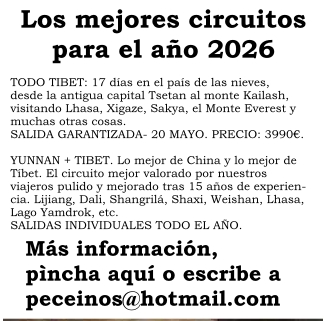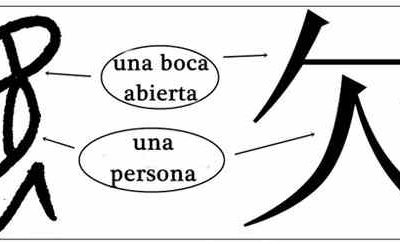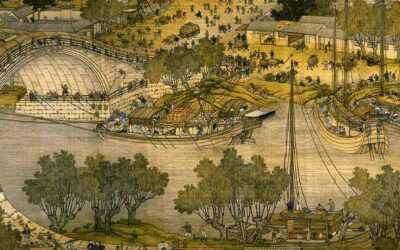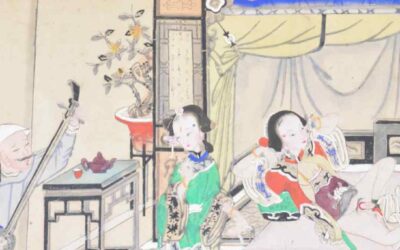On the left side was a densely wooded rocky hill. Its steep slope was carved into fantastic figures of unicorns, leogryphs and other mythological animals, and statues of gods and saints. They had been fashioned out of rock by the monks more than fifteen centuries ago. Under the hill were grottoes and caves filled with Buddhas and genii, where pilgrims were burning incense. Mantras in Sanskrit and archaic Chinese adorned the rocks, chiselled by the long departed hermits.]
Walking a little farther we came to the spacious entrance hall of a monastery which was unique in China in its grandeur, sanctity.
‘The Monastery of the Spirit’s Retreat’, softly exclaimed Chungan pointing to the three huge golden characters over the wide-open doors of the hall.
‘What a deep and secret meaning these words possess ! ‘ he continued. ‘It is a fitting name for this place, for it is difficult to conceive a better hermitage for the spirit of a man tired of the world and seeking concealment amidst the beautiful and tranquil.
Having emerged from this hall with its golden statue of Maitreya, the Lord Buddha of the Future, we stepped out into a large stone-flagged courtyard bounded by ancient trees. In front of them, on a high stone platform, flanked by two small pagodas and with a massive bronze incense burner in the middle, stood the main temple hall. its great height and immense size dwarfed all other buildings around it. The roof rose in three nobly curved tiers supported by colossal red wooden pillars.
The latticed gates of the hall were open as we came in. A mysterious semi-darkness, heavy with the odour of sandal-wood incense, pervaded the place. Right in the middle of the vast temple sat three golden Buddhas of such unbelievable majesty and of such gigantic proportions that when I saw them I was astonished. The images rested on lotus flowers which, in turn, were supported by stupendous stone pedestals. A colossal lantern, richly carved and decorated, with a perpetually-burning oil-lamp within, was suspended in front of the Trinity.
The central figure was that of the Lord Buddha himself with his royal coiffure and a sign of urna on his forehead. With the eyes turned inwards, gazing not at the world outside before him but at the world within himself; with his enigmatic smile, he sat there a true image of the man that he once was, but who had transcended all human emotions, desires, all suffering and mundane joy; who had found the lost path to Heaven and shown it to suffering mankind, and who at last had entered Nirvana and became himself a God. I gazed enchanted at the mystic statue. I felt mesmerized by the utter stillness of the temple. Clouds of incense floated in spirals towards the lofty ceiling and gently dissolved there in the golden rays of the sun coming through the narrow windows. The very silence was pregnant with the meaning of things unsaid, of prayers uttered and of petitions yet unoffered.
After we had finished our tour of the golden statues of arhats, lining the walls, and paused before an enormous image of the gentle Goddess Kwanyin, which stood against an altar piece representing the Western Paradise, we made our exit by a side door into a commodious guest hall where a young novice brought us cups of the monastery’s own tea. He smiled at Chungan and Tsungpoo, evidently recognizing them as frequent visitors. After a good rest we were ready to proceed to the next famous temple.
Goullart, Peter. Monastery of the Jade Mountain.
Peter Goullart. The monastery of Jade Mountain.
More posts on Chinese culture
El Primitivista: el filósofo taoísta de la simplicidad
El Primitivista: el filósofo taoísta de la simplicidad. El clásico taoísta, Zhuangzi no es la obra de un solo filósofo Cualquiera que se acerque un poco a las obras fundamentales del taoísmo enseguida descubre que el libro llamado Zhuangzi no es la autoría del...
Un antiguo libro sobre la minoría Sani-Yi
Alguien se preguntará si tiene algún sentido leer en las primeras décadas del siglo XXI un libro escrito en las últimas del XIX. Está claro que la persona que ha gastado un poco de su tiempo traduciéndolo, revisándolo, cambiando los nombres antiguos a la escritura...
Reconocimiento al libro sobre los caracteres chinos
Reconocimiento al libro sobre los caracteres chinos ¡Buenas noticias!Me alegra compartir que mi libro Chinese Characters: An Easy Learning Based on Their Etymology and Evolution, la versión inglesa de “Caracteres chinos: un aprendizaje fácil basado en su etimología y...
El Festival Qingming: De Fiesta de Primavera a Festival de los Muertos
El Festival Qingming: De Fiesta de Primavera a Festival de los Muertos. El Festival Qingming (清明节) es en la actualidad el Día de los Muertos en China, la fecha en la que la gente se acuerda de sus familiares fallecidos y viaja a los cementerios situados en las afueras...
El Escepticismo de Linghu Zhuan le lleva a los Infiernos
El Escepticismo de Linghu Zhuan le lleva a los Infiernos Linghu Zhuan era un hombre de gran integridad que no creía en dioses ni espíritus. Siempre que alguien hablaba sobre las transformaciones de los fantasmas o la retribución divina en el más allá, él refutaba sus...
¿Existió un arte de la alcoba taoísta homosexual?
¿Existió un arte de la alcoba taoísta homosexual? Esto es lo que se propone Zhang Wanrong en un interesante artículo aparecido el año pasado en la revista “Religions”[1]. El arte de la alcoba taoísta Para los que no estén familiarizados con el asunto, entre las...
More posts on China ethnic groups
El Primitivista: el filósofo taoísta de la simplicidad
El Primitivista: el filósofo taoísta de la simplicidad. El clásico taoísta, Zhuangzi no es la obra de un solo filósofo Cualquiera que se acerque un poco a las obras fundamentales del taoísmo enseguida descubre que el libro llamado Zhuangzi no es la autoría del...
Un antiguo libro sobre la minoría Sani-Yi
Alguien se preguntará si tiene algún sentido leer en las primeras décadas del siglo XXI un libro escrito en las últimas del XIX. Está claro que la persona que ha gastado un poco de su tiempo traduciéndolo, revisándolo, cambiando los nombres antiguos a la escritura...
Reconocimiento al libro sobre los caracteres chinos
Reconocimiento al libro sobre los caracteres chinos ¡Buenas noticias!Me alegra compartir que mi libro Chinese Characters: An Easy Learning Based on Their Etymology and Evolution, la versión inglesa de “Caracteres chinos: un aprendizaje fácil basado en su etimología y...
El Festival Qingming: De Fiesta de Primavera a Festival de los Muertos
El Festival Qingming: De Fiesta de Primavera a Festival de los Muertos. El Festival Qingming (清明节) es en la actualidad el Día de los Muertos en China, la fecha en la que la gente se acuerda de sus familiares fallecidos y viaja a los cementerios situados en las afueras...
El Escepticismo de Linghu Zhuan le lleva a los Infiernos
El Escepticismo de Linghu Zhuan le lleva a los Infiernos Linghu Zhuan era un hombre de gran integridad que no creía en dioses ni espíritus. Siempre que alguien hablaba sobre las transformaciones de los fantasmas o la retribución divina en el más allá, él refutaba sus...
¿Existió un arte de la alcoba taoísta homosexual?
¿Existió un arte de la alcoba taoísta homosexual? Esto es lo que se propone Zhang Wanrong en un interesante artículo aparecido el año pasado en la revista “Religions”[1]. El arte de la alcoba taoísta Para los que no estén familiarizados con el asunto, entre las...







